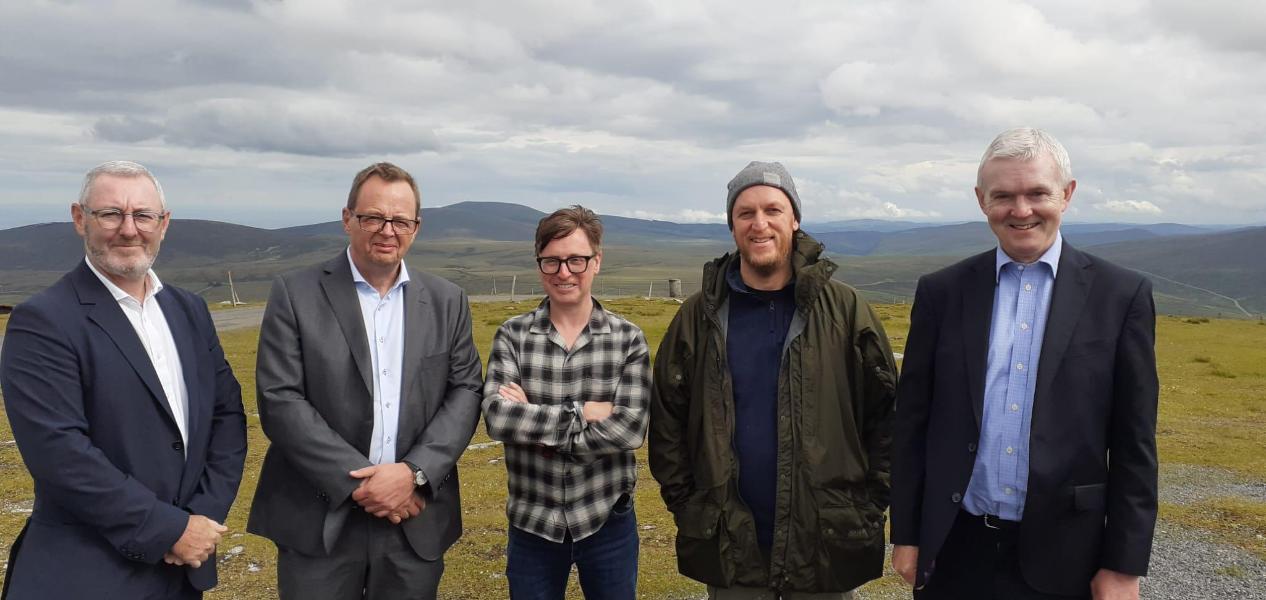
- Technical cooperation to scale up rehabilitation of peatlands with nationwide engagement and strengthened monitoring
- The cooperation will further develop the Peatland Finance Ireland initiative, investing in nature and local development
- New initiative to support the restoration of peatlands and address the climate and biodiversity impact of landscapes degraded by drainage and abstraction
On Thursday 30th June, Minister for Housing, Local Government and Heritage Darragh O’Brien TD, and EIB Vice-President Christian Kettel-Thomsen formally agreed to strengthen cooperation for peatland restoration in Ireland with the European Investment Bank supporting NPWS efforts to accelerate the restoration of peatlands across the country.
After the meeting, Minister O’Brien said: “Irelands is privileged as a country to hold some of the largest reserves of peatland habitat within Europe, covering over 20% of Ireland’s terrestrial territory. Significant progress is being made on peatlands restoration and rehabilitation in Ireland but the co-operation between the National Parks and Wildlife Service, as a strong voice for nature conservation, with the EIB can contribute to the scaling up of biodiversity and climate ambitions for peatlands on a national level.”
“The European Investment Bank, the EU’s climate bank, is committed to supporting investment to improve resilience to a changing and more extreme climate. Restoring degraded bogs is crucial to revitalising nature and improving resilience to a changing climate. Beautiful peat habitats across Ireland are vitally important for biodiversity and provide important carbon stores and sinks.” said Christian Kettel-Thomsen, European Investment Bank Vice President.
The new cooperation brings together Government and state-owned enterprises, the private sector and local actors under a coordinated strategy for planning and financing peatland rehabilitation.
It will address climate and biodiversity challenges, use the latest scientific methods and unlock creation of economic opportunities. The new scheme builds on extensive experience already gained in Ireland and stakeholder engagement that enables investing in natural capital.
Peatland Finance Ireland a pioneer in Europe
The Peatland Finance Ireland initiative aims align the carbon and biodiversity agenda with opportunities for communities and regional development. The Initiative is engaging the broadest possible range of stakeholders, including corporates. Corporates have a wide range of motivations, include net zero carbon strategies, securing supply chains and Environmental and Social Governance. Consultation with Irish industry has shown a strong appetite for projects that follow science-based targets and integrate multiple benefits, for climate, biodiversity and society. They are already piloting projects that are shifting perceptions of investing in natural processes.
The creation of the Peatland Finance Ireland initiative has built on support provided by NPWS in 2021 under the Natural Capital Finance Facility, a joint EC-EIB financial instrument for biodiversity and nature-based climate adaptation, leading to the creation of a PFI stakeholders group.
Minister and Vice President visit Intel peatland restoration scheme
Following the signature of the new agreement the Minister and Vice President visited the blanket bog Restoration project in the Wicklow Mountains National Park to see how Intel Corporation is investing in peat as part of global investment to enhance water storage.
The project will restore 60 hectares of previously drained bog wetted to increase water storage levels in part of the River Liffey headwaters by an expected 50-90 million litres. These headwaters supply the Poulaphouca (Blessington) reservoir, a drinking water source for the Greater Dublin Area. The bog restoration will also protect biodiversity, improve carbon storage, and is likely to improve water quality.
This is the first water restoration project funded in Europe as part of Intel’s commitment to achieve net positive water globally, by 2030. This public-private project collaboration is one of the first of its kind in Ireland for water restoration and the protection of biodiversity.
There is an estimated 4,000 hectares of degraded blanket bog in the National Park. Degraded blanket bog is more susceptible to damage from extreme weather events such as intense rainfall and extended periods of drought, which are projected to occur more frequently with climate change.
Restoring peatlands to meet climate targets
Peatlands are central to both Irelands future climate and biodiversity commitments. Rehabilitating Ireland’s peatlands has the potential to reduce national carbon emissions by an order of 5-10 %. Healthy peatlands are important for water security, and also help mitigate both droughts and flooding events, in addition to being biodiversity hotspots.
Scaling up peatland restoration within an accelerated timeframe will require significant upfront investment and deployment of skills for planning and execution and systemic stakeholder engagement. Physical implementation will follow a phased approach, integrating the developing understanding of the complex peatlands, building a comprehensive set of standards and systems for monitoring and verification.
Europe’s Peatlands
Peatlands are the largest terrestrial stores of carbon and a record of time. They have arisen from local geological and hydrological conditions leading to the build-up – often over millennia – of dead plant matter.
European peatlands developed over millennia. However, their wet soils are highly vulnerable to degradation and ecological transformation associated with human induced pressures such as peat extraction, land reclamation in low-lying coastal areas, conversion to grassland, afforestation with non-native woodlands, and now, climate change. It is estimated that at least 25% of the world’s peatlands have been damaged or lost, with the scale of deterioration most notable in Western Europe (~ 90%). In European countries with significant peatland cover (> ~ 10%), such as Ireland, England, the Netherlands and Germany, peatlands are significant sources of CO2, with European emissions estimated at ~ 5%.
The close link between climate and nature has been acknowledged in EU-level goals to focus ecosystem restoration efforts on areas with high carbon sequestration potential, as the only actual proven scalable method for carbon removal from the atmosphere. Reducing emissions from land and reversing the situation to one of carbon sequestration is a key element of EUs net zero strategy, Peatlands have a separate mention in the new proposal for an EU Nature Restoration Law.